論説
Scratch an industry leader, and you’ll find an ironclad procurement operation. What companies like Apple and Walmart have learned on the way to the top of their industries is that procurement leaders are cost leaders with a clear edge over rivals. Cost leaders can out-invest in innovation, capture share through price flexibility and quickly capitalize on new opportunities—all while retaining margins. In a recent Bain & Company study of procurement in the Asia-Pacific region, we found no company executives who would describe their capabilities as world class. Compare that with an earlier survey of North American executives: The 15% of respondents who felt their companies had world-class procurement also were those with the industry-leading costs.
Procurement represents the lion’s share—as much as 80%—of overall costs in some industries like automobiles, textiles and electronics. Yet the vast majority of executives readily admit that their companies rely on procurement capabilities that are no better than those of their competitors.
Nowhere is the pressure to improve procurement as intense as in Asia-Pacific, both for domestic companies and multinationals that rely on the region as an important source of goods and services. The pursuit of world-class procurement is as critical in developing countries as it is in the region’s developed countries.
Companies operating in China, India and other emerging economies face the pressing need to impose efficiency on their fast-growing operations. Undeniably, swift growth, combined with shorter product cycles, has left companies with the challenge of dealing with massive operating complexity. The effect of each new product is felt throughout the supply chain: everywhere from sourcing to logistics to warehouse management. Planning gets more complex each time a new product or SKU is introduced.
In addition to complexity, there is the matter of cost inflation. In these countries, revenues are growing rapidly, but input costs are growing even faster—and eating into margins. And there’s also an issue that our study found is even more vexing for some Asia-Pacific executives than rising input prices: volatility.
For their part, companies in developed markets, like Australia and Japan, must accommodate rising and volatile input costs as they deal with slow-growing economies. As top-line growth falls off, they need to find ways to shore up profits.
To address all of these ills, companies throughout the region have dutifully set aggressive targets for reducing input costs—but always in a short period of time. Trouble is, despite their best intentions, too many executives tell us they are simply ill-prepared to meet their goals.
We conducted 60 interviews with business heads and chief procurement officers (CPOs) throughout Asia-Pacific and heard the same repeated theme: While many report their capabilities are fair or even good, none feel they are great. They are saddled with procurement operations that lag global best practices. Our study found that procurement teams in Asia-Pacific often lack organizational support and prominence, tend to focus on short-term activities, rely on inadequate demand management processes, and struggle with underdeveloped supply bases and insufficient core procurement processes such as category management. They lack systematic supplier management processes, reliable data systems and strong procurement talent. For example, while some companies make a serious point of investing in procurement talent, they fail to take the critical move of defining a clear career path for procurement professionals.
Fortunately, they can learn from the best. Even companies that are woefully behind can quickly build capabilities to manage procurement, with processes and systems that match the maturity of global leaders. There’s a clear view of what great looks like. Instead of simply being content to eliminate any waste, tighten any processes and provide any improvement in spending control and visibility, companies can go much further. They can adopt the practices of what we refer to as “4th generation” procurement—using the procurement function as a way to add value to the business year after year, shoring up the bottom line by keeping costs from mounting.
Inspired by the best
There’s a well-defined evolutionary path to the 4th generation (see Figure 1). In our experience, when companies tackle procurement, they start out by becoming what we call “Tactical Buyers.” They may advance to become “Optimized Sourcers.” And, if they’ve invested to give prominence to the procurement function, they’ll evolve into “Strategic Procurers,” comprehensively aligning their procurement and business strategies.
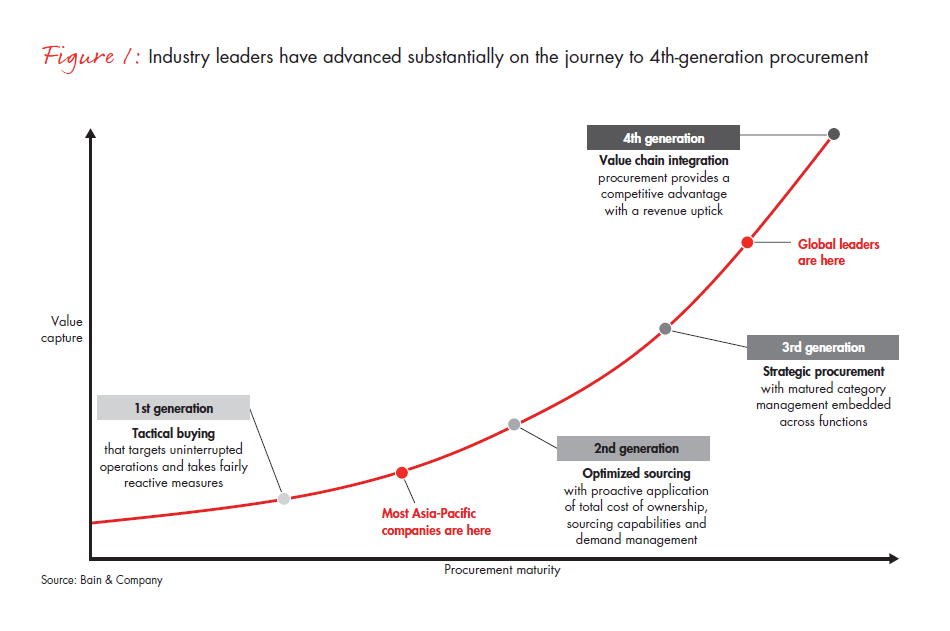
But the goal is to evolve to the 4th generation and to do it with all of six enablers—and in a sequence that is dictated by industry dynamics and a company’s goals (see Figure 2). In a growing market, for example, it makes sense to start by investing in IT. However, if the primary concern is around margin protection and efficiency, the priority is to develop the right tools and methodology for consistency.
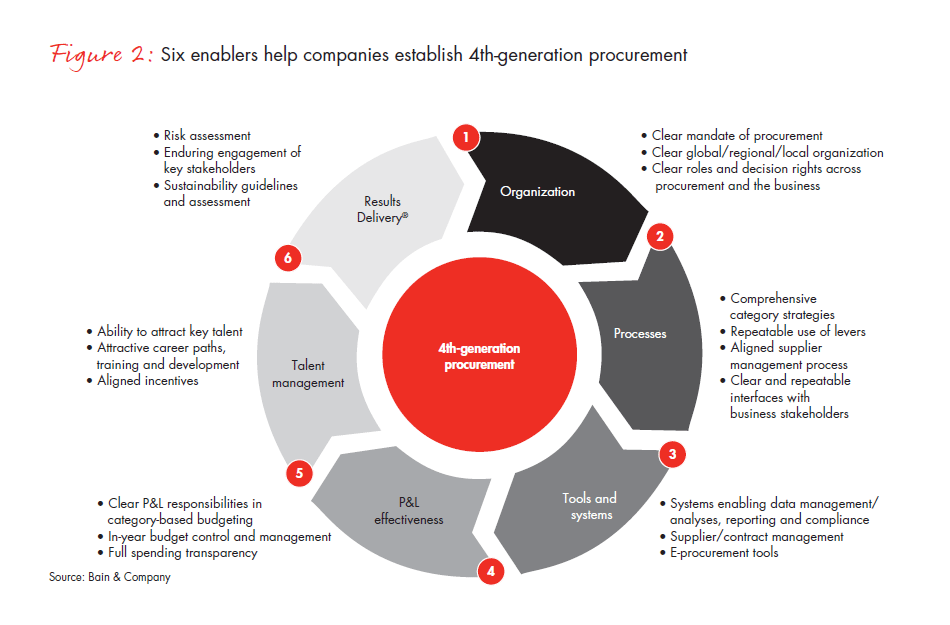
Companies with 4th-generation procurement capabilities have so tightly integrated their back-end procurement and front-end marketing and sales systems that procurement costs can be identified at a micro level—by a particular batch, for example. Such a tight alignment allows marketing to take specific steps such as running focused campaigns that could generate incremental market share at a local or regional level.
From our extensive research in Asia-Pacific, we’ve seen very few companies with full 4th-generation capabilities. However, different companies have gained significant ground in one or more of the important areas. For example, some players lead their industries in category management while others are winners when it comes to forging strategic partnerships. Meanwhile, other companies excel at pull-based demand management or have established state-of-the-art talent management capabilities that are well beyond the industry norm— and deliver consistent results. With a dedicated effort and a continuous improvement culture supported by the complementing capabilities, we’ve seen companies repeatedly achieve 3% to 4% savings year over year, following initial savings of 8% to 12%.
What does 4th-generation procurement look like? Based on our work with clients and our study of procurement capabilities in Asia-Pacific, we’ve identified the criteria that raise companies above their rivals and identified winners for each of the enablers.
Organization. How do companies choose a mandate and structure to maximize procurement gains? Among the critical moves: They elevate decisions about specification targets to senior management, weave savings goals into daily processes and deploy a rigorous system for regular reviews. They continually improve, embedding a feedback loop from internal customers and end consumers.
Consider the organizational changes that LG Electronics made to squeeze huge savings from procurement. With procurement spending representing 70% to 80% of the company’s revenues, LG realized that the only way to boost performance would be to overhaul its procurement structure. Until 2008, procurement in its business units was managed separately, according to product lines: There was a different procurement group for washing machines, for refrigerators and for other product lines in the digital appliance division (now called home appliance). The arrangement was essentially destined to foster procurement inefficiencies. For example, the company could spend significantly more for the same part for a washing machine as for a refrigerator. To prevent such cost leaks, the company reorganized its procurement organization into separate groups representing each stage of the manufacturing process, regardless of the product. Press, injection, electronic and circuit, cutting, and mold and die casting groups now manage spending across the companies, guided by global commodity managers.
Reporting channels also changed. All procurement teams now typically report to a CPO or head of procurement. And procurement now has a seat at the table in top executive consensus meetings involving brand teams and chief functional officers. Those meetings serve as a platform to develop and promote best practices and identify key bottom-line improvements. The transformed organization focused on saving $4.7 billion in direct material spending in 2008. By adding in indirect spending the following year, the company saved nearly $6 billion out of $24.8 billion in total spending. Procurement’s impact on the bottom line is estimated at $30 billion from 2008 to 2012, and it remains a key factor in LG’s continued success.
Processes. Companies that ascend to 4th-generation procurement slavishly focus on the critical processes they need to get right: category management, vendor development and the quality of information. For example, they rigorously evaluate suppliers and contracts, always conducting a total-cost-of-ownership analysis. These companies strike strategic partnerships with suppliers that have the best technological capabilities and invest in stringent supplier management.
With major operations throughout Asia-Pacific, the UK-based mining company Rio Tinto manages nearly 60,000 suppliers across 46 spending categories, ranging from explosives and rail equipment to human resources and travel services. Its procurement entity, Rio Tinto Procurement, centrally manages global, regional and project procurement with consistent methods and processes: It works with internal customers to identify short- and long-term needs and develops expert knowledge of supply markets, vendors and value levers. To minimize costs and maximize value, it implements regional category strategies, taking a total-cost-of-ownership approach. Then it consistently and systematically manages its suppliers through predefined key performance indicators (KPIs) and common objectives. Along with other initiatives, Rio Tinto’s procurement operation will contribute to the company’s expected cost savings of more than $5 billion by the end of 2014.
Tools and systems. 4th-generation procurement companies rely on customized, dynamic dashboards that provide integrated and transparent data for both direct and indirect spending, highlighting performance gaps. Consider Ford Motor Company’s Global Product Development System. Under the system, selecting a headlamp supplier for production in a low-cost country is no different than it is for production in the US or Europe. And the dashboard on a decision maker’s computer in Dearborn perfectly mirrors that of a counterpart in Shanghai or New Delhi. With seamless access to centralized information around the globe, procurement managers quickly see and adapt best practices. For instance, they may note that a global supplier of headlamps has a production facility in Asia that faces more quality challenges than does its facility in Europe. With this comparison in hand, the company can actively work with the supplier to improve its record and meet global standards for all its facilities.
P&L effectiveness. To boost the effectiveness of the P&L, companies with 4th-generation capabilities establish pull-based demand management with enforced compliance and formalized budgeting for all categories. At one leading retailer, an advanced category management toolkit allows the company to see the direct effect of its sourcing decisions on the bottom line—a first step in alerting it to the need to make adjustments. Companies find that high-complexity categories require much more attention and willingness to reach out across the enterprise, and they require suppliers to hit their targets. But by laying out clear financial parameters, category managers and suppliers together can work toward improving results. For example, in the automotive industry it is common for original equipment manufacturers and suppliers to work together and share best-practice manufacturing knowledge and Lean Six Sigma implementation. That way, they can jointly work to improve the time required for specific steps in a top supplier’s production process.
Talent management. Leaders make a serious point of investing in talent. They establish procurement as a grooming ground for leadership and manage performance through well-defined KPIs and incentives. When Royal Philips Electronics created its separate Philips General Purchasing operation in 2004, it reassessed all of its existing procurement employees according to the skills that would be required in the new organization. Many didn’t meet the profile, so Philips used the opportunity to recruit staff with deeper skills—a move that allowed it to build a team that was not only more talented but leaner. A key factor in the success of Philips’s procurement organization: linking it to decision makers throughout the company. Now, whenever a key person in procurement is being recruited, stakeholders are con-sulted in the process. And, to prevent them from operating in a vacuum, top procurement managers are full members of Philips’s functional boards.
Results Delivery®. To stay on task during a major change management effort and to sustain results, forward-thinking firms establish risk teams that track and manage all transactional and strategic risks. The Dow Chemical Company took this route when, under CEO Andrew Liveris, it dramatically moved in a new direction toward sustainability. When Dow Chemical set ambitious targets in sustainable chemicals and in such areas as clean water, the reverberations were felt in procurement. Suddenly, suppliers now would be evaluated not on cost alone, but also on sustainability. To carefully track progress and continuously manage risk, Dow Chemical implemented a system of feedback loops. Supply managers routinely sit down with business unit managers to review supply management performance and jointly determine ways to improve.
Roadblocks to success
Why aren’t more companies following the lead of trailblazers like Ford, LG and Dow Chemical? While the route to 4th-generation procurement is clearly laid out, the majority of Asia-Pacific companies face a host of internal and external obstacles. Our interviews with executives and internal experts in a range of industries helped us understand exactly what’s standing in the way (see Figures 3 and 4).
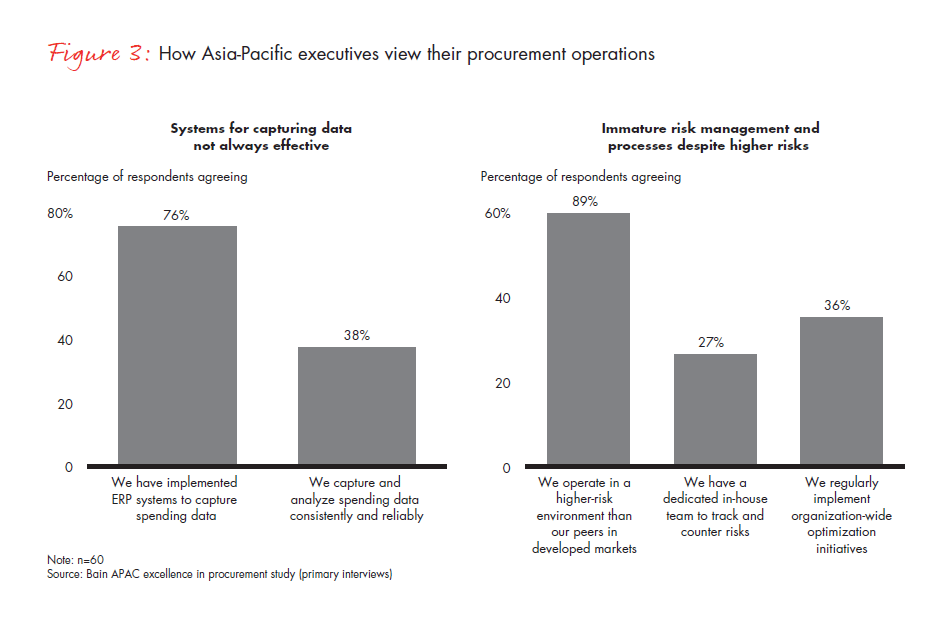
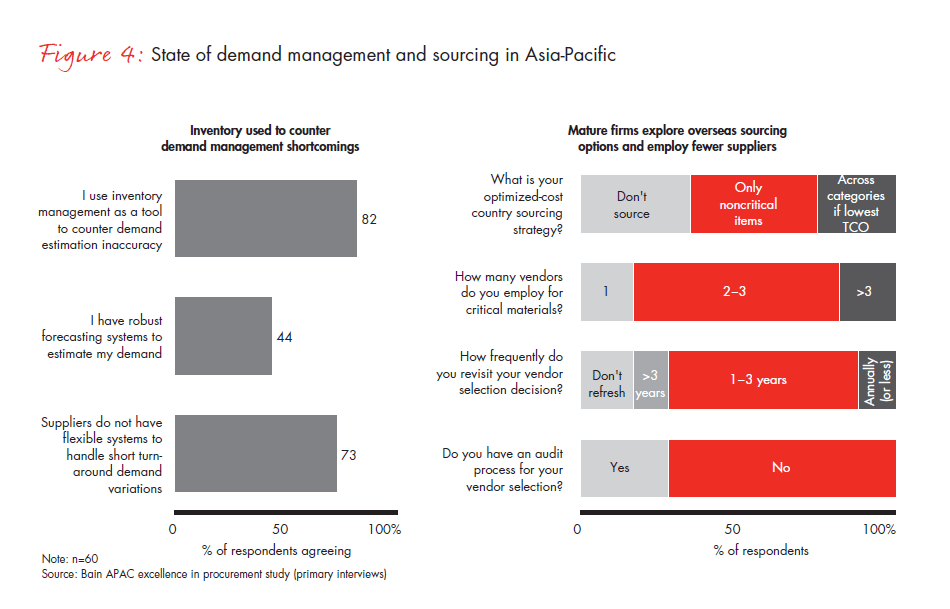
Fully 66% of interviewed Asia-Pacific executives told us that procurement simply doesn’t get the prominence it needs across systems, processes and people to deliver results. For example, companies are stymied by limited programs for grooming and managing procurement talent. Among the reasons procurement is often viewed as an undervalued back-office support function: Lacking impressive cost-saving results from procurement initiatives, many companies don’t understand how important it can be for improving the bottom line.
Honest self-assessments helped us clearly see the important issues facing Asia-Pacific procurement decision makers. For instance, while more than 50% of interviewed executives understand all elements of total cost of ownership, only 15% employ it effectively across all decisions. And 82% admit they use inventory to counter shocks in demand forecasts, instead of relying on robust demand management planning processes and systems.
The executives in our study also told us their supply bases are underdeveloped. More than half of the CEOs we interviewed are concerned about the availability of good suppliers, and 67% are concerned about unfair supplier selection practices. The issue of unfair supplier selection is a tricky one. In our experience, companies often try to address that shortcoming by adding administrative processes to monitor supplier selection. But that typically leads to more bureaucracy and inefficiency— making it harder to make the leap from good to great. Adding to the difficulties is the fact that less than half of our study participants have visibility into supplier costs.
Another area for improvement: effectively capturing data and market intelligence. The quality of data in the region’s emerging markets, in particular, is insufficient. In our experience, companies make quick fixes with new systems, but often fail to go the full distance with improvements that allow them to analyze spending data consistently and reliably. And when companies set out to boost the quality of their data, they often make a fundamental oversight: Decisions on how to improve data often aren’t led by the business.
Raymond Tsang, a leader in Bain's Asia-Pacific Performance Improvement practice, explains how a world-class procurement process is essential for success in these developing markets.
How to get there
These and other roadblocks aren’t insurmountable. The path to achieving 4th-generation maturity differs for each company, based on the sophistication of its existing operation, its unique objectives and the industry or market dynamics. Yet all companies pursuing changes and hoping to make those changes stick typically start with the same first step: a relatively simple diagnostic that lets them clearly see where they’re starting from (see below, “See where you stand”).
In the diagnostic, companies ask and answer a series of questions such as, “Are more than 80% of our suppliers (by value) integrated into the supply chain with real-time data visibility?” “Is the organization designed for swift and effective decision making?” “Are IT systems helping to continuously identify improvement opportunities?” and “Is category-based budgeting applied across the business?”
Armed with the answers, companies approach procurement initiatives in three key areas:
Spending transparency. The first goal of any procurement organization is to ensure it has a complete and accurate picture of its spending, that all information is continuously maintained and the database is accessible for procurement professionals across the organization. Bringing full spending visibility under one roof leads to higher rates of compliance, to the point that maverick spending becomes almost extinct.
Going beyond savings delivery. The goal is to identify the savings full potential and the steps that can be taken to capture those savings. To this end, leaders analyze category and cost structure, as well as the supplier landscape for each category. They conduct category workshops to verify findings, develop initiatives for each category and estimate the savings potential of each initiative. The results can be impressive. Fostering competition among a broader supplier base and sourcing from best-cost countries allowed Rio Tinto to save 50% on the cost of truck pads and to source truck trays that are 40% cheaper than it previously paid.
As part of this process, successful companies look for quick wins and assess initiatives on an ease-of-implementation basis. The right moves can lead to initial savings of 8% to 12%. For example, one PC company saved more than $20 million in its first year—and identified $250 million annual savings across multiple categories—by tackling five areas. It controlled demand by revising purchasing policies and deferring some purchases. It invested to better understand its markets and suppliers, which armed it to more effectively negotiate prices. The company consolidated volume, designed to cost and developed integrated systems for total cost of ownership.
Sustainability. With procurement savings identified and with the right steps in place, the next move is to ensure the savings stick year after year. Companies focus on three areas.
First, they establish corporate and cross-functional interfaces. For example, procurement needs to work closely with the business, operating toward common targets and motivated by common KPIs, all managed through a rigorous process for incorporating feedback from internal customers. As required, companies make organizational changes to help them meet customer needs.
Second, companies refine core procurement management capabilities. In our experience, category management and supplier management are the two most important processes for achieving sustainable results.
Finally, they design their organizations for sustained results. For example, they organize for identifying and quickly making the most important decisions—and at the right level.
We’ve found that companies following this approach can save on procurement year after year. After initial cost savings in the 8% to 12% range, the best players typically deliver 3% to 4% cost reductions per year.
Whether a company in Asia-Pacific is struggling with the fallout of growing too rapidly or the challenges of a cooling economy, it needs a world-class procurement organization to control costs better than rival firms. Executives are candid about their shortcomings in this area. They lag behind global best practices in everything from supplier management to business intelligence. But for those who choose to improve, advancing to 4th-generation procurement begins with a single step: performing a basic diagnostic to learn, in important detail, where you’re starting from and what you stand to gain by taking the journey.
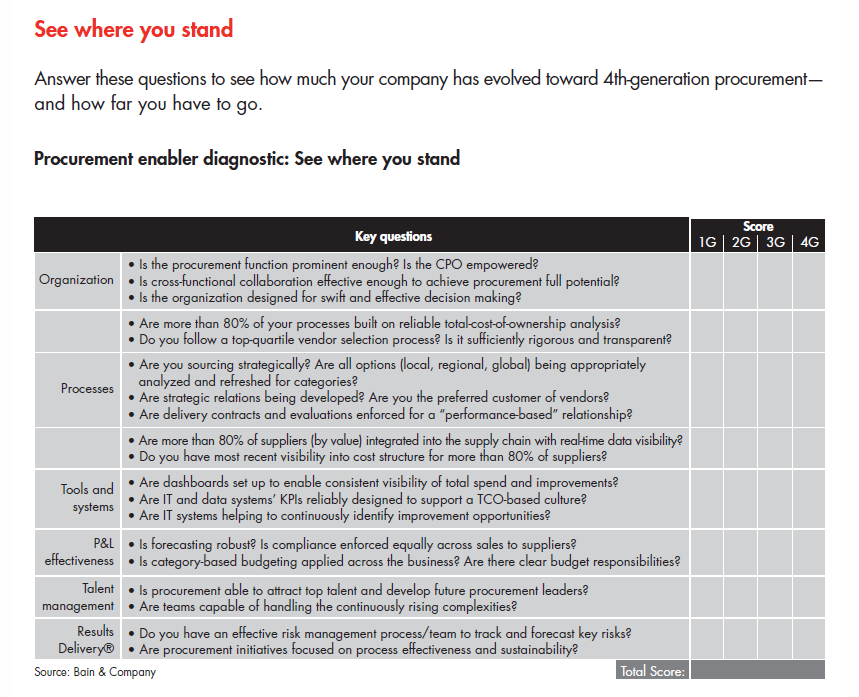
Raymond Tsang is a partner in Bain & Company’s Shanghai office and a leader in the firm’s Performance Improvement practice. Amit Sinha is a Bain partner based in New Delhi and a leader in the firm’s Industrial Goods & Services practice. Gerry Mattios is a Bain principal based in Beijing.




